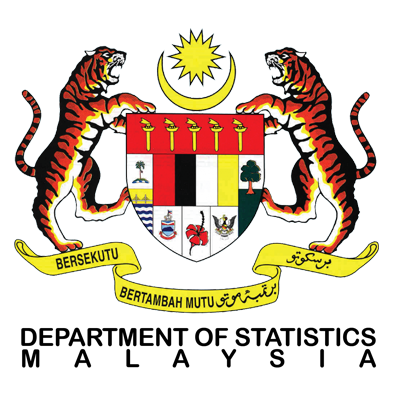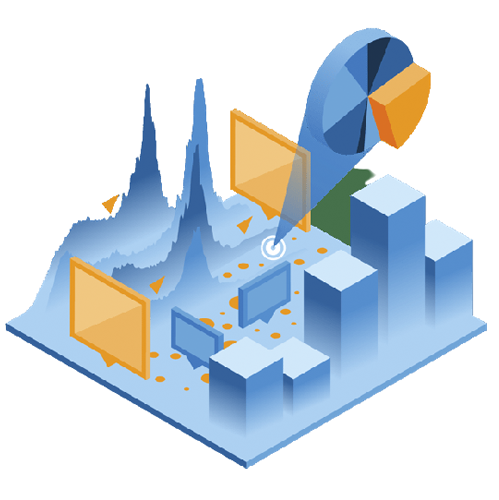Gross Domestic Product by State
- Home
- Statistics
- Economy
- National Accounts
- Gross Domestic Product by State
Gross Domestic Product (GDP) by State, 2023
Overview
MALAYSIA ECONOMIC PERFORMANCE, 2023
In line with the slower global economic performance in 2023, Malaysia's economy grew moderately by 3.6 per cent as compared to the robust growth of 8.9 per cent in 2022, with the Gross Domestic Product (GDP) amounting to RM1.6 trillion (Chart 1). The Services and Manufacturing sectors remained as the primary drivers of Malaysia's economy, contributing a cumulative 82.6 per cent to the total GDP, registered a growth of 5.1 per cent (2022: 11.0%) and 0.7 per cent (2022: 8.1%) respectively. Meanwhile, the Agriculture sector expanded by 0.7 per cent (2022: 1.3%), while the Mining & quarrying sector registered a marginal growth of 0.5 per cent (2022: 3.5%). Nevertheless, the Construction sector strengthened by 6.1 per cent as against 5.1 per cent in the previous year.
Chart 1: Annual percentage change of GDP, Malaysia, 1991-2023
The Services sector, which is the main contributor to the national economy with a contribution of 59.2 per cent (Exhibit 1), grew by 5.1 per cent (2022: 11.0%). The performance was supported by strong growth in key subsectors such as Wholesale & retail trade, 5.9 per cent (2022: 13.7%), Transport & storage, 13.8 per cent (2022: 29.4%) and Food & beverage and accommodation, 7.7 per cent (2022: 34.7%). Five (5) states recorded growth exceeding the national level, namely Selangor (6.1%), Pahang (6.0%), Pulau Pinang (6.0%), Johor (5.4%), and Sarawak (5.4%).
Exhibit 1: Annual growth and percentage share by kind of economic activity, 2023
The Manufacturing sector, contributing 23.4 per cent to Malaysia's GDP, grew at a slower rate of 0.7 per cent (2022: 8.1%). This marginal growth was primarily influenced by the declines in the production of export-oriented products, specifically Electrical, electronic, and optical products contracted by 1.6 per cent (2022: 14.2%), while Petroleum, chemical, rubber, and plastic products experienced a decrease of 0.8 per cent (2022:1.1%). As a result, states that are major producers of Electrical, electronic, and optical products such as Pulau Pinang, Kedah and Kelantan registered a negative growth of -0.5 per cent, -3.2 per cent and -2.6 per cent respectively in the Manufacturing sector. Within the same period, the decline in Petroleum, chemical, rubber, and plastic products of 4.6 per cent (2022: 6.3%) in Sarawak contributed to the decrease of 3.9 per cent (2022: 5.8%) in the Manufacturing sector of this state. On the other hand, the Non-metallic mineral products, basic metals, and fabricated products, rose by 5.2 per cent, offsetting the sector’s overall decline.
The Agriculture sector experienced a marginal growth of 0.7 per cent, as compared to 1.3 per cent in 2022. This slower growth was influenced by the Crop (1.5%), Livestock (0.7%) and Fisheries (0.5%) as well as the decline by 9.0 per cent in Forestry & logging subsectors. Oil palm, which was the main contributor to the Crop subsector, recorded a marginal growth of 0.2 per cent, as against 3.8 per cent in the previous year. The Livestock subsector also grew marginally by 0.7 per cent, while Other crop subsector showed an increase of 3.7 per cent (2022: -0.2%). Four (4) states that contributed almost 60 per cent to the total GDP of the Agriculture sector have had a significant impact on the marginal growth of this sector, namely Johor (-1.1%), Sarawak (2.0%), Pahang (2.5%), and Sabah (0.8%).
Malaysia's Mining & quarrying sector also showed marginal growth of 0.5 per cent (2022: 3.5%), boosted by the Natural gas subsector which grew 0.6 per cent (2022: 5.3%) and Other mining & quarrying, 3.6 per cent (2022: 10.2%). In contrast, the Crude oil & condensate subsector continued its decline, worsening to -0.4 per cent in 2023 (2022: -0.3%). The weak global demand for crude oil, coupled with a series of geopolitical conflicts that caused a drop in world crude oil prices, has negatively impacted the two states that dominate the sector, Sabah and Sarawak, resulting in negative growth of -5.2 per cent and -1.0 per cent, respectively.
The Construction sector strengthened 6.1 per cent as compared to 5.1 per cent in the previous year. This growth was led by Civil engineering, Special Trade activities, and Building construction, with an increase of 14.5 per cent (2022: -0.9%), 6.5 per cent (2022: 6.5%), and 0.8 per cent (2022: 8.1%) respectively. Among the states that support the strong performance of this sector were Pahang (37.1%), Kedah (30.8%), Pulau Pinang (23.6%), Johor (13.2%), and Selangor (10.2%).
Exhibit 2: Economic growth by state and kind of economic activity, 2023

ECONOMIC PERFORMANCE BY STATES, 2023
In 2023, Johor, Malaysia's third-largest economic contributor, achieved a value added of RM148.2 billion (2022: RM142.4 billion), marking a 4.1 per cent increase as compared to 8.5 per cent growth the previous year (Exhibit 2). The Services sector expanded by 5.4 per cent (2022: 11.0%), driven by growth in Wholesale & retail trade, accommodation, food & beverages, as well as Utilities, transport and ICT subsectors. The Manufacturing sector expanded by 2.8 per cent, supported by increases in Electrical, electronic & optical products as well as Petroleum, chemical, rubber & plastic products, particularly chemical products. The Construction sector continued to strengthen by recording a growth of 13.2 per cent (2022: 15.9%), due to double-digit growth in the Civil engineering and Specialised construction activities. Meanwhile, the Agriculture sector shrank by 1.1 per cent (2022: 3.1%), influenced by the drop in the Crop subsector (Oil Palm).
Kedah's economy expanded by 1.6 per cent in 2023 (2022: 7.3%), reaching a value added of RM51.8 billion, up from RM51.0 billion in 2022. The Services sector grew by 4.0 per cent (2022: 8.0%), driven by increases in the Wholesale & retail trade subsector, accommodation and food & beverage services, as well as Utilities, transport and ICT subsector. In contrast, the Manufacturing sector contracted by 3.2 per cent as compared to 8.1 per cent growth in 2022, primarily due to the decline In Electrical, electronic & optical products, as well as Vegetable and animal oils & fats, food processing, beverages and tobacco products. Meanwhile, the Construction sector experienced a significant surge with a 30.8 per cent increase (2022: 18.3%), driven by double digit growth across all its subsectors. However, the Agriculture sector encountered a 2.8 per cent decline, primarily due to the reduction of oil palm and rubber production.
Kelantan's value added increased by 2.6 per cent (2022: 4.5%), reaching RM27.6 billion as compared to RM26.9 billion in 2022. This growth was fueled by a 3.8 per cent expansion in the Services sector, driven by Wholesale & retail trade, accommodation, food & beverages, and Government services. However, the Agriculture sector contracted by 0.5 per cent, mainly due to declines in the Forestry & logging subsector. The Manufacturing sector also declined by 2.6 per cent (2022: 3.1%), affected by decreases in Electrical, electronic & optical products, as well as Wood products, furniture, paper products, and printing. Meanwhile, the Construction sector grew by 6.7 per cent (2022:19.7%), primarily supported by Specialised construction activities.
Melaka's GDP increased by 3.0 per cent (2022: 8.9%), reaching RM46.9 billion as compared to the RM45.6 billion recorded in the previous year. The Services sector moderated to 4.2 per cent growth as compared to 12.4 per cent in 2022, with significant contributions from Wholesale & retail trade, accommodation, food & beverages, and Other services. Meanwhile, the Manufacturing sector experienced marginal growth of 0.3 per cent (2022: 6.8%), influenced by the declines in Electrical, electronic & optical products, though offset by strong performance in Petroleum, chemical, rubber & plastic products. The Agriculture sector expanded by 6.5 per cent, driven by increases in the Crop (vegetables) and Livestock subsectors. Construction sector grew by 5.7 per cent, supported by a positive growth in Civil engineering and Construction of buildings subsectors.
Negeri Sembilan recorded a value added of RM51.9 billion in 2023 (2022: RM50.9 billion), representing a 1.8 per cent increase as compared to 6.6 per cent growth in the previous year, driven by Services and Manufacturing sectors. The Services sector grew 4.5 per cent (2022: 7.8%) owing to Utilities, transportation, ICT as well as Wholesale & retail trade, accommodation, and food & beverages. The Manufacturing sector moderated to 1.2 per cent (2022: 8.0%), following marginal growth in Electrical, electronic & optical products. Meanwhile, the Agriculture sector experienced a decline of 4.9 per cent, primarily influenced by the Crop subsector, particularly oil palm.
Pahang's economy expanded by 5.2 per cent (2022: 11.4%), exceeding the national growth rate of 3.6 per cent, with its GDP reaching RM64.9 billion as compared to RM61.7 billion in the previous year. Pahang which is dominated by the Services sector expanded by 6.0 per cent, (2022: 16.9%) driven by growth in tourism-related industries such as Wholesale & retail trade, accommodation, food & beverages, and Other services. Meanwhile, the Manufacturing sector grew to 2.1 per cent (2022: 5.8%) driven by the Petroleum, chemical, rubber & plastic products which expanded 6.7 per cent. The Agriculture sector in grew by 2.5 per cent (2022: 6.8%), supported by Crop (fruits) and Fisheries subsectors. Meanwhile, the Construction sector in Pahang surged by 37.1 per cent (2022: -1.0%). This growth rate stood out as the highest among all states, driven by Civil engineering and Specialised construction activities.
In 2023, Pulau Pinang’s GDP reached RM116.0 billion, reflecting a moderate growth of 3.3 per cent (2022: 13.3%). The Services sector recorded a growth of 6.0 per cent (2022: 11.5%) driven by Wholesale & retail trade, accommodation and food & beverage as well as Utilities, transport and ICT. The Manufacturing sector which is the second highest contributor shrank by 0.5 per cent (2022: 15.9%) affected by the decrease in Electrical, electronic & optical products due to reduced demand for E&E products globally.
Perak's economy grew 2.7 per cent as compared to 4.6 per cent in the previous year. The Services sector moderated to 3.0 per cent (2022: 7.4%), influenced by the Wholesale & retail trade, accommodation and food & beverage and Government services subsectors. The Manufacturing sector grew by 2.2 per cent (2022: 1.0%) driven by an increase in Non-metallic products, basic metals and fabricated metal products as well as Vegetable and animal oils & fats, food processing, beverages and tobacco products. The Agriculture sector recovered to 1.9 per cent (2022: -2.6%), supported by Crop (vegetables) and Fisheries. Meanwhile, the Construction sector recorded 0.2 per cent decline (2022: 6.1%), affected by the downturn in the Construction of buildings subsector.
Perlis GDP grew 2.1 per cent in 2023 (2022: 5.9%), reaching a value added of RM6.3 billion, up from RM6.2 billion the previous year. The Services sector, leading the economy, grew by 2.3 per cent (2022: 5.6%), supported by Government services and Wholesale & retail trade, accommodation, and food & beverage subsectors. The Agriculture sector increased by 4.1 per cent (2022: 3.4%), driven by growth in the Crop subsector, particularly paddy and fruits. In contrast, the Manufacturing sector in Perlis contracted by 1.0 per cent (2022: 4.5%) due to the decreases in Vegetable and animal oils & fats, food processing, beverages and tobacco products as well as Petroleum, chemical, rubber, and plastic products.
Selangor continues to be the fastest-growing economy, surpassing national growth, with a 5.4 per cent increase in 2023 (2022: 11.9%), reaching a value added of RM406.1 billion (2022: RM385.2 billion). The Services sector, leading the economy, grew by 6.1 per cent (2022: 13.6%), supported by Wholesale & retail trade, accommodation, food & beverage, as well as Utilities, transport, and ICT. The Manufacturing sector moderated to 2.0 per cent growth (2022: 9.0%), supported by Vegetable and animal oils & fats, food processing, beverages and tobacco products, as well as Non-metallic products, basic metals, and fabricated metal products. Meanwhile, the Construction sector strengthened to 10.2 per cent (2022: 4.2%) driven by all subsectors especially Civil engineering. Conversely, the Agriculture sector contracted by 7.3 per cent (2022: -0.5%) affected by the decline of the Fisheries, Crop and Forestry & logging subsectors.
Terengganu recorded a GDP value of RM38.2 billion, an increase of 2.3 per cent from 6.0 per cent in 2022. The Services sector grew by 3.1 per cent (2022: 6.0%) supported by Government services as well as Wholesale & retail trade, accommodation and food & beverage. Next, the Manufacturing sector grew marginally by 0.2 per cent (2022: 8.3%) influenced by the main leaders of this sector namely Petroleum, chemical, rubber & plastic products. The Agriculture sector in Terengganu recovered by 7.4 per cent (2022: -3.3%) due to an increase in the Crop (fruits and vegetables) and Fisheries subsectors. The Construction sector grew by 1.6 per cent (2022: 3.4%) driven by the Civil engineering subsector.
Sabah's GDP grew by 1.3 per cent as compared to 3.9 per cent in the previous year, to record value added amounting to RM83.2 billion (2022: RM82.1 billion). The Services sector grew 4.5 per cent (2022: 8.5%), driven by tourism-oriented industries, such as Wholesale & retail trade, accommodation and food & beverages. The Mining & quarrying sector which was the second contributor to the state's economy continuously drop to 5.2 per cent (2022: -0.6%), due to the fall in the Crude oil & condensate and Natural gas subsectors. The Agriculture sector grew marginally by 0.8 per cent (2022: 0.2%), following contraction in the Fisheries, Forestry & logging and Livestock subsectors. Nevertheless, the improvement in the performance of the Crop subsector, especially oil palm, has reduced the impact of this sector's decline. In contrast, the Manufacturing sector increased by 4.4 per cent (2022: -2.5%) driven by Vegetable and animal oils & fats, food processing, beverages and tobacco products.
Sarawak's GDP grew by 1.2 per cent (2022: 6.9%) with an economic value of RM142.4 billion (2022: RM140.7 billion). The Services sector grew by 5.4 per cent (2022: 9.3%), led by the Wholesale & retail trade, accommodation and food & beverage as well as Utilities, transport and ICT subsectors. The Manufacturing sector shrank 3.9 per cent (2022: 5.8%), influenced by the declines in Petroleum, chemical, rubber, and plastic products, particularly refined petroleum products which decreased by 4.7 per cent. The Mining & quarrying sector also contracted by 1.0 per cent (2022: 7.3%) following declines in the Crude oil & condensate and Natural gas subsectors. However, the Agriculture and Construction sectors increased by 2.0 per cent and 8.3 per cent respectively have supported the positive growth of the state's economy.
W.P. Kuala Lumpur which is Malaysia's second largest economy, grew by 3.7 per cent to register a value added of RM249.3 billion (2022: RM240.5 billion) surpassing GDP growth at the national level. Its economy, which was dominated by the Services sector, grew 4.9 per cent (2022: 11.0%), supported by the Wholesale & retail trade, accommodation and food & beverage and Government services subsectors. Meanwhile, the Manufacturing sector increased by 1.8 per cent (2022: 5.3%), contributed by Wood products, furniture, paper products and printing.
W.P. Labuan recorded a growth of 1.9 per cent as compared to 4.1 per cent in the previous year, with a value added of RM8.1 billion (2022: RM8.0 billion). The Services sector, leading the economy, expanded by 2.2 per cent (2022: 4.8%), supported by growth in the Finance, insurance, real estate & business services as well as Wholesale & retail trade, accommodation and food & beverage subsectors. Within the same period, the Manufacturing sector grew marginally by 0.4 per cent (2022: 1.7%), supported by Non-metallic mineral products, basic metals and fabricated metal products as well as Petroleum, chemical, rubber & plastic products
GDP PER CAPITA BY STATES, 2023
Table 1: GDP per capita (RM) by states, 2023
Regarding to GDP per capita performance, most states witnessed an increase in 2023, except for Pahang, Terengganu, Sabah, Sarawak, and W.P. Labuan. Five (5) states surpassed the national GDP per capita level (RM54,612) namely W.P. Kuala Lumpur (RM131,038), W.P. Labuan (RM83,596), Pulau Pinang (RM72,586), Sarawak (RM72,411), and Selangor (RM62,492), as illustrated in Table 1.
Press Statement
Subscribe
Newsletter
Subscribe to our newsletter and stay updated
For interviews, press statement and clarification to the media, contact:
Baharudin Mohamad
Public Relation Officer
Email: baharudin[at]dosm.gov.my
Phone: 03 8885 7942
Not found what you looking for? Request data from us, through
Go to eStatistik
email to data[at]dosm.gov.my
call 03 8885 7128 (data request)










